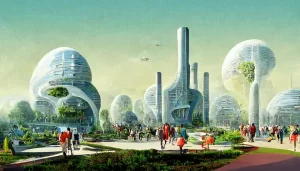Entrepreneurs have become the heroes of current business lore, and many companies realize that they need more entrepreneurial spirit in their organizations and future talent pools.
But not everyone is cut out to be an entrepreneur. It would be foolish to think that you can turn all of your employees into entrepreneurs. Most people are not resilient enough for that path, and it’s not that you would want everyone to suddenly be an entrepreneur anyway.
That said, the future will require competencies for everyone that are more akin to an entrepreneur than a typical employee.
These new competencies can indeed be taught — we are doing that with our clients all the time, and it is wonderful to see the spark go off, when people realize that they indeed have the capacity to create, to change, to make things happen beyond their job description.
Those new competencies are direly needed in a constantly accelerating, uncertain and complex world, in which orienting ourselves on higher values and purpose is essential to finding direction.
We are living in times of VUCA, which do require a new kind of organizational context and a new breed of future high potentials.
The Shifting Organizational Context
An organization on the basic level is a conceptual container that provides the Why?, the How?, and the What? of a collective human endeavor.
Right now, we are in the midst of a conceptual shift of what an organization stands for:
The Why? is shifting from Profit to Purpose.
We have already impoverished “Profit” as a concept, as it used to stand for more than just the financial metrics used to measure it, so it is not surprising that people are looking for more meaning in their work. Both employees, especially millennials, as well as customers, are demanding Purpose beyond Profit from companies.
What is it, that you are actually moving in the world? What impact are you creating as an organization?
The How? is shifting from Mechanics to Meaning.
A smooth business used to be a proprietary black box with a collection of well-defined repeatable processes. In a world where AI and robotics are replacing anything repeatable, the How? of an organization is no longer mostly about mechanics, but more so about creating an environment of meaning, where each employee has an understanding of the impact they are creating and has the opportunity and permission to live their purpose inside their activities for the organization and its ecosystem.
How are you giving your employees the opportunity to engage and collaborate on meaningful activity internally and external to the organization?
The What? is shifting from Product to People.
In part due to the success of design thinking, and in part due to the acceleration in product and service development afforded by a reusable (and often free) technology stack, there is a shift from the focus on new products and services to a focus on customer lifestyle.
If you wish to innovate Blue Ocean strategies, you can no longer be bound by your products. You need to understand and empathize with future lifestyles (B2C) or operations (B2B), and institutionalize a pipeline for business models across multiple time horizons to support those new ways of being and relating.
How are you creating a focus on people over products? What are your visions for the future lifestyles/ operations of your customers?
The shifting Why?, How? and What? of an organization require new High-Potentials.
Future High-Potentials
Future high-potentials are different from past high-potentials. That brings a few problems with it:
- Selection — Currently, successful past high-potentials recruit future high-potentials. Those, who “have made it” in the organization are often the ones who are identifying potential successors. Naturally, they are looking for younger versions of themselves. This will not necessarily identify actual future high-potentials, but more likely provide your with “more of the same”.
- Development — Current paths for high-potentials are mired in the thinking of the past. Skills and competencies taught, while still valid, are missing crucial elements and are insufficiently preparing them for the future. More important than skills training is training in meta-skills such as independent and continuous learning.
- Engagement — New high potentials require the opportunity to create value in new ways. This can include intrapreneurial projects. The problem is that most organizations do not have pathways or support systems for future high-potentials and for the projects they could create for the organization. Instead, most organizations are doing what a colleague of mine refers to as “innovation theater”, paying lip service to innovation, spending money on design thinking or hackathons, or whatever other buzzwords or new panaceas, while missing the point of creating a transformational organization with actual pathways for integrating new business models into their core business (this being one of the reasons so many companies are currently closing their accelerators).
Selecting High-Potentials
Following Kotter’s idea of shifting from a hierarchical to a networked organization, we found that the best way to select future high-potentials is to let them select themselves.
Instead of only relying on current management to spot people like themselves among their staff, we found that creating opportunities to participate in future crafting activities (e.g. intrapreneurship programs), gives your employees the opportunity to step up into leadership.
Of course, not everyone who applies to such a program is indeed cut out for future leadership, but it gives you a first indication of Self-Reliance, of intrinsic purpose-driven motivation, one of the three keys to the future.
Developing High-Potentials
In a world where information is practically free, teaching skills is becoming somewhat redundant. Instead, employees learn skills on demand as the situation or their projects requires them — learning by doing.
What is more important than skills is the ability to acquire them. The ability to learn, to have a growth mindset, to understand oneself as a constantly evolving being.
This constantly evolving being requires the capacity to level herself, to center, to connect to something beyond the constantly changing surface and distraction of reality. Talent of the future requires the capacity for Self-Management, the second crucial capacity for the future.
Engaging High-Potentials
Finally, high-potentials require opportunities and guidance around creating value collaboratively not just across the organization, but across entire ecosystems.
This will allow them to create those new networked structures, which will eventually replace many of our current hierarchical or vertically integrated business systems. It will create those organizational contexts of the future that high-potentials will want to continue to work in — supporting retention of top talent.
Building new contexts will require Self-Organization, the third crucial piece for future talent. Self-Organization is about creating shared purpose, alignment, enrollment, commitment and authentic relating— capacities unfortunately too rarely taught to our children.
Holonic Approach
Self-Reliance, Self-Management and Self-Organization are three key elements we see for the future of work (more on future of work scenarios in my last article).
The future will require a decidedly holonic approach.
A holon (Greek: ὅλον, holon neuter form of ὅλος, holos “whole”), akin to a fractal, is something that expresses itself simultaneously as a whole and a part. The word was originally coined by Arthur Koestler in his 1967 book “The Ghost in the Machine”.
A holonic approach is about understanding that each of us is whole by ourselves and part of larger systems at the same time. That we are ultimately alone and need to rely on ourselves first. That nobody is coming to save us or the world, and that we cannot abdicate responsibility, but have to stand in ownership of our reality.
In order to stand in full ownership of our reality, and to be truly present rather than reactive, we require the tools to center ourselves, to self-regulate our various systems that comprise our interfaces into our reality: our body, emotions, mind, relationships and higher level creative circuitry.
Finally, while we are alone and whole as such, we can only create so much by ourselves. To create impact in the world, we need to collaborate with others and build systems that allow them to express their own wholeness.
And now even beyond the boundaries of the organization…
Into the Future
We are in the midst of one of the greatest human adventures.
We are in the midst of becoming whole as a planet and extent our capacity to collectively create value from organizations to entire ecosystems.
Thanks to the technologies we have evolved as a species, our awareness now reaches not just to distant shores on a world that might as well be flat, but to our pale blue sphere from above, where our wholeness as part of the universe is undeniable.
Now we need to the future human talent to make it so.
This article originally appeared on The Future Shapers, a global network of thought-leaders, innovation practitioners, business leaders, academics and speakers who have come together with the aim of helping businesses and other organisations to shape and create innovative futures.





